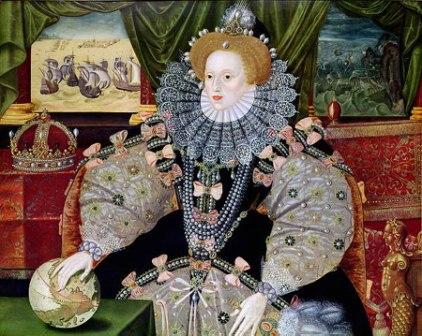On This Day in Elizabethan History, June 23rd, 1600 Queen Elizabeth I of England attended the wedding celebrations of Henry, Lord Herbert and his bride Anne Russell. Anne Russell had come to court in 1594, becoming one of Queen Elizabeth's last maids of honor. Queen Elizabeth repaid Anne for her good service by electing to attend her wedding week celebrations. It was a great honor to have the reigning sovereign attend your nuptials, and although Queen Elizabeth was growing older she still traveled with all the pomp and circumstance of her younger years. Her arrival was a display of unbridled majesty that the bride and groom would never forget.
Luckily, there are several contemporary sources that chronicle this splendid event. The foremost literary account comes to us from Rowland White. White was a representative for Sir Robert Sidney at court while he was away serving as Lord Governor of Flushing (Ruggles-Strong, 17). Anne Russell's impending nuptials with the Earl of Worcester's son Henry, Lord Herbert (not to be confused with Henry Herbert, the 2nd Earl of Pembroke) were of great interest to those in high society. So, White dutifully included details about Russell's "exceeding preparacions" (original spelling retained) for the wedding in his frequent correspondence with his master, as well as documenting the actual celebration.
White describes the Queen (a mere three years before her death) as being "in very good health". This matches the other contemporary descriptions we have of Queen Elizabeth in her old age. White reported to Sidney that the Queen planned to "honor Mrs. Anne Russell's marriage with her presence" (Ruggles-Strong, 18). On June 14th there was an elaborate masque at Greenwich Palace to celebrate the wedding, and on June 16th, the couple were married in St. Martin Ludgate, London.
"This day senight her majestie was at Blackfriars to grace the marriage of Lord Harbert and his wife. The bride met the Queen at the water-side, where my Lord Cobham had provided a letica, (horse-litter) made like a litter, whereon she was carried to my Lady Russell's by six knights. Her Majesty dined there, and at knight went through Dr. Puddins (Sir William Paddy's house) who gave the Queen a fanne (fan) to my Lord Cobham's, where she supped...Her Majesty on Tuesday came back again to court." -from The Sidney Papers, quoted in Stubbes's Anatomy of the Abuses in England in Shakespeare's Youth, pg.71.
One of the most famous paintings of Queen Elizabeth I is Queen Elizabeth Going in Procession to Blackfriars. It depicts her being carried in an open-air letica by her maternal kinsmen on her way to celebrate the wedding of Anne Russell and Lord Henry Herbert, who are shown following behind (after all, it may have been their wedding week, but their was no mistaking who was the real star of the show!). The painting, attributed to both Marcus Gheeraerts the elder and Robert Peake is in the collection of Colonel Wingfield-Digby in Sherborne Castle, Dorset (unless it has changed hands in recent years).
Queen Elizabeth I is depicted with her throat and bosom bare, as only married ladies were required to wear closed ruffs or partlets. Anne Russell also dons the style, as this was the last occasion that she would be permitted to dress in the youthful fashion. While Elizabeth had long styled herself a virgin, the Queen adopted more pronounced styles that con-notated youth and virginity in her old age (Stubbes, 71-72). Looking old was one of the few things that Elizabeth Tudor feared (because of her vanity, but more importantly because she did not want her people to perceive her as infirm and thus cause them to start wagging their tongues about the succession). The wide, open neck framed by the Queen's elaborate whisk does not appear in portraits or on coins dating earlier than 1601 (Stubbes, 72).
Sources:
Stubbes, Phillip, Babington, Gervase, and Neogeorgus, Thomas. Phillip Stubbes's Anatomy of the Abuses in England in Shakespeare's Youth, A.D. 1583. London: Trubner & Co., 1877.
Ruggles Strong, John. Note Upon The "Dark Lady" Series of Shakespeare's Sonnets. New York: G.P.
Putnam's Sons, 1921.


